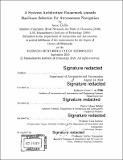A systems architecture framework towards hardware selection for autonomous navigation
Author(s)
Collin, Anne(Anne Claire)
Download1143738749-MIT.pdf (29.07Mb)
Other Contributors
Massachusetts Institute of Technology. Department of Aeronautics and Astronautics.
Advisor
Olivier L. de Weck.
Terms of use
Metadata
Show full item recordAbstract
The inclusion of autonomous vehicles into our transportation networks requires methods for evaluation and certification of systems on the vehicle. Adding sensors or computing capabilities to the vehicle might improve performance for specific tasks, or resilience, but can also be accompanied with an increase in cost, system latency, and energy consumption. Currently, no method exists to quantify the trade-offs between these metrics of interest at the system level. This thesis provides a framework to support hardware selection by presenting a method to evaluate the effect of sensor type and placement on the vehicle's ability to perform Simultaneous Localization and Mapping (SLAM), and select high performing and resilient sensor architectures for realistic driving situations from the benchmarked KITTI dataset. For the specific sequence considered, this thesis shows that designing for resilience increases cost by only 4%. It is also found that LiDARs are critical to the performance and resilience of sensing systems in many different environments. A systems model for processor and bus selection is then developed, in order to minimize cost and latency of the hardware architecture, taking into account recent safety measures recommended by the ISO 26262. This model enables the evaluation of the impact of sensor choice on the overall latency. A new method is proposed to enumerate efficiently sensor architectures and place them in the tradespace containing four dimensions of interest: cost, latency, energy consumption and SLAM performance. It is found that, due to diminishing returns, the best architecture is 360% more expensive than the second best, for a performance increase of 1%. Finally, the framework is applied to specific situations such as the test of a new sensor, or poor weather conditions, providing architecture insights for the intelligent transportation community.
Description
Thesis: Ph. D., Massachusetts Institute of Technology, Department of Aeronautics and Astronautics, 2019 Cataloged from PDF version of thesis. Includes bibliographical references (pages 189-207).
Date issued
2019Department
Massachusetts Institute of Technology. Department of Aeronautics and AstronauticsPublisher
Massachusetts Institute of Technology
Keywords
Aeronautics and Astronautics.